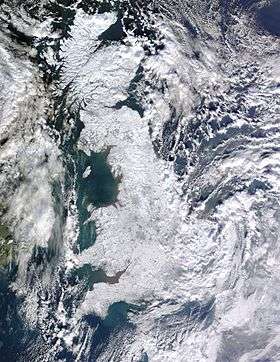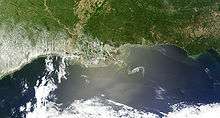Terra (satellite)
 Terra (EOS AM-1) | |
| Mission type | Climate research |
|---|---|
| Operator | NASA |
| COSPAR ID | 1999-068A |
| SATCAT № | 25994 |
| Website |
terra |
| Spacecraft properties | |
| Manufacturer | NASA |
| Launch mass | 4,864 kilograms (10,723 lb) |
| Start of mission | |
| Launch date | December 18, 1999, 18:57:39 UTC |
| Rocket | Atlas IIAS AC-141 |
| Launch site | Vandenberg SLC-3E |
| Contractor | ILS |
| Orbital parameters | |
| Reference system | Geocentric |
| Regime | Low Earth |
| Semi-major axis | 7,080.0 kilometers (4,399.3 mi) |
| Eccentricity | 0.0001392 |
| Perigee | 708.7 kilometers (440.4 mi) |
| Apogee | 710.6 kilometers (441.5 mi) |
| Inclination | 98.2098° |
| Period | 98.8 minutes |
| RAAN | 251.3130 degrees |
| Argument of perigee | 83.7699 degrees |
| Mean anomaly | 276.3654 degrees |
| Mean motion | 14.57110250 |
| Epoch | 25 June 2016, 02:58:27 UTC |
| Revolution number | 87867 |
 | |
Terra (EOS AM-1) is a multi-national NASA scientific research satellite in a Sun-synchronous orbit around the Earth.[1] It is the flagship of the Earth Observing System (EOS). The name "Terra" comes from the Latin word for Earth.
Launch
The satellite was launched from Vandenberg Air Force Base on December 18, 1999, aboard an Atlas IIAS vehicle and began collecting data on February 24, 2000. It was placed into a near-polar, sun-synchronous orbit at an altitude of 705km, with a 10:30am descending node.
Mission
Terra carries a payload of five remote sensors designed to monitor the state of Earth's environment and ongoing changes in its climate system:[2]
- ASTER (Advanced Spaceborne Thermal Emission and Reflection Radiometer)[3]
- CERES (Clouds and the Earth's Radiant Energy System)
- MISR (Multi-angle Imaging SpectroRadiometer)
- MODIS (Moderate-resolution Imaging Spectroradiometer)[4]
- MOPITT (Measurements of Pollution in the Troposphere)[5]
Data from the satellite helps scientists better understand the spread of pollution around the globe. Studies have used instruments on Terra to examine trends in global carbon monoxide and aerosol pollution.[6] The data collected by Terra will ultimately become a new, 15-year global data set.
Malicious Cyber Activities
In June and October 2008 the spacecraft was targeted by hackers who gained unauthorized access to its command and control systems but did not issue any commands.[7]
Gallery of images by Terra
 The first image taken by Terra.
The first image taken by Terra. The Solar eclipse of August 1, 2008, over Russia, Norway, and the Arctic Ocean as seen from NASA's Terra satellite.
The Solar eclipse of August 1, 2008, over Russia, Norway, and the Arctic Ocean as seen from NASA's Terra satellite. The effects of the European winter storms of 2009–2010 on Great Britain, seen from Terra.
The effects of the European winter storms of 2009–2010 on Great Britain, seen from Terra. The Deepwater Horizon oil spill oil slick as seen from space by NASA's Terra satellite on May 1, 2010.
The Deepwater Horizon oil spill oil slick as seen from space by NASA's Terra satellite on May 1, 2010. The Deepwater Horizon oil slick just off the Louisiana coast on April 30, 2010, visible from space.
The Deepwater Horizon oil slick just off the Louisiana coast on April 30, 2010, visible from space. Hurricane Karl, the most destructive hurricane of the 2010 Atlantic Hurricane Season, approaches Mexico on September 16.
Hurricane Karl, the most destructive hurricane of the 2010 Atlantic Hurricane Season, approaches Mexico on September 16.
See also
| Wikimedia Commons has media related to Terra (satellite). |
References
- ↑ "NASA: TERRA (EOS AM-1)". nasa.gov. Retrieved 2011-01-07.
- ↑ Maurer, John (November 2001). "Overview of NASA's Terra satellite". hawaii.edu (University of Hawai'i). Retrieved 2011-01-07.
- ↑ Stevens, Nicki F.; Garbeil, Harold; Mouginis-Mark, Peter J. (2004-01-22). "NASA EOS Terra ASTER: Volcanic topographic mapping and capability" (PDF). Hawai'i Institute of Geophysics and Planetology. Retrieved 2011-01-07.
- ↑ "MODIS Terra Satellite Images". ucar.edu(National Center for Atmospheric Research: Earth Observatory Laboratory). Retrieved 2011-01-07.
- ↑ "MEASUREMENTS OF POLLUTION IN THE TROPOSPHERE (MOPITT)". acd.ucar.edu (NESL's Atmospheric Chemistry Division). Retrieved 2011-01-07.
- ↑ "NASA's Terra Satellite Tracks Global Pollution". gsfc.nasa.gov (Goddard Space Flight Center). 2004-05-18. Retrieved 2011-01-07.
- ↑ "2011 REPORT TO CONGRESS of the U.S.-CHINA ECONOMIC AND SECURITY REVIEW COMMISSION, page 216" (PDF). uscc.gov. Retrieved 2012-10-09.